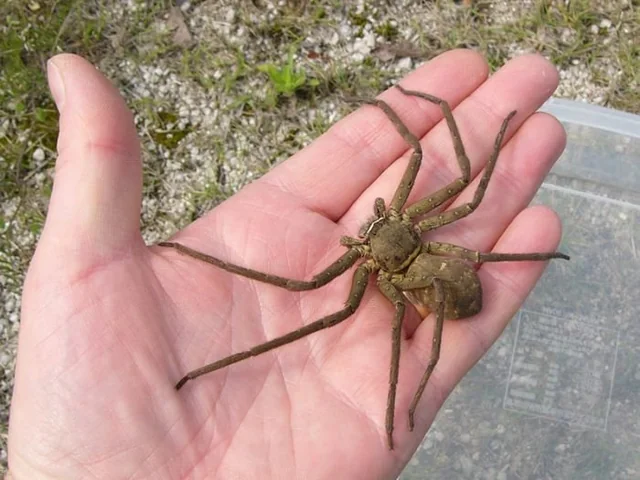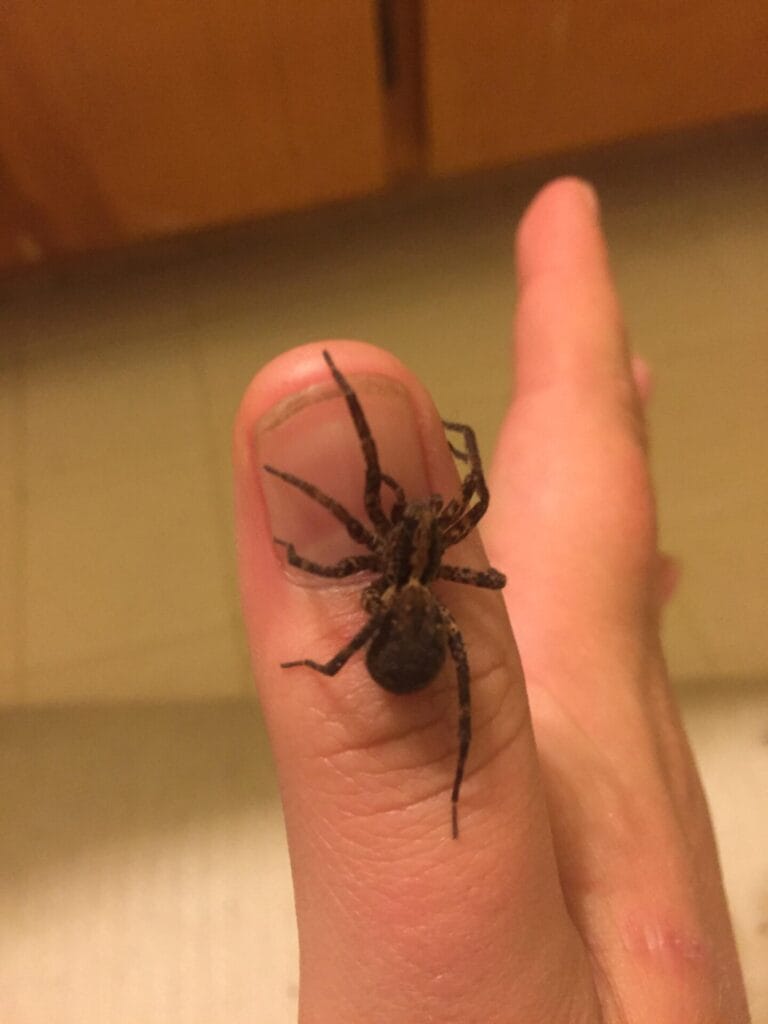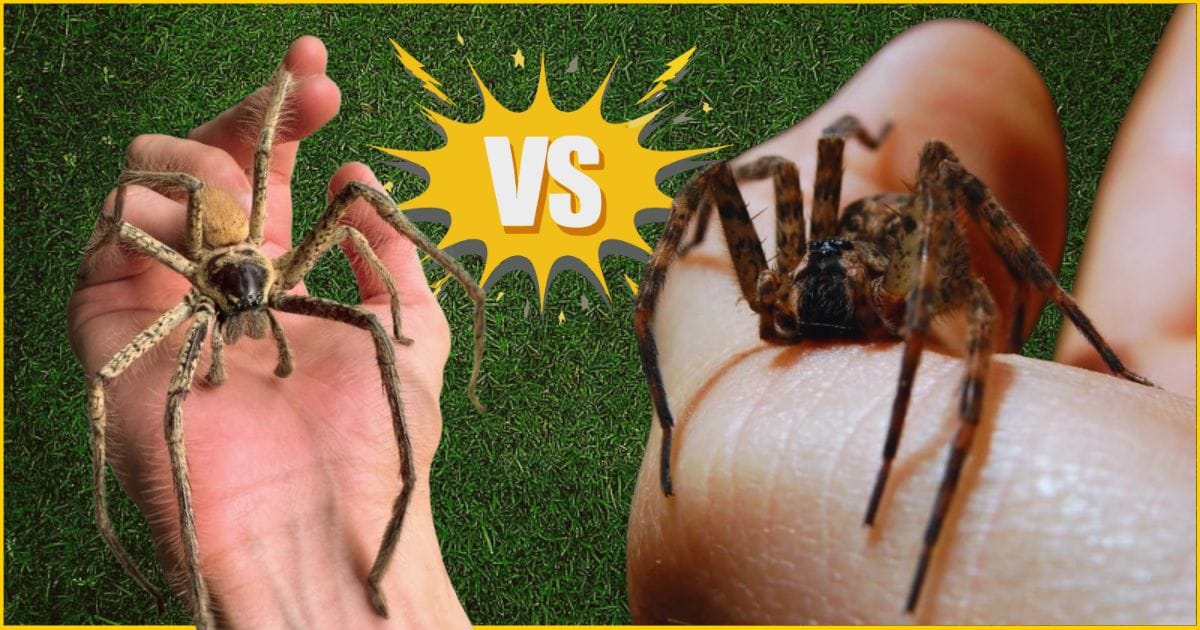Imagine walking through your backyard at sunset and suddenly spotting a fast moving spider with long legs or seeing one slip out from under a leaf. Encounters like this happen around the world and they often lead to curiosity, fear, or both.
Two spiders that often create such moments are the Huntsman Spider and the Wolf Spider. Both are known for their speed and strong hunting skills, but they are very different when it comes to appearance, behavior, and lifestyle.
In this article, Huntsman Spider vs Wolf Spider, you will get a closer look at these two fascinating species. We will share interesting facts, clear up common myths, and highlight what makes each spider unique.
With easy to understand explanations, a comparison table, and answers to common questions, this article is perfect for students, researchers, or anyone who wants to better understand the secret lives of these skilled hunters.
Table Of Contents
- Huntsman Spiders, AKA Giant Crab Spiders or Wood Spiders
- Common Myths And Facts About Huntsman Spiders
- Wolf Spiders, AKA Ground Spiders or Hunting Spiders
- Common Myths And Facts About Wolf Spiders
- Huntsman Spider vs Wolf Spider: Full Comparison Table
- Frequently Asked Questions (FAQs)
Huntsman Spiders, AKA Giant Crab Spiders or Wood Spiders

- Family: Sparassidae
- Nickname: Giant Crab Spider due to their leg shape and sideways movement.
- Fastest spider in the world, with some species capable of running up to 1 meter per second.
- Known for their remarkable size: The giant huntsman can reach up to 12-inch leg spans, making it the largest spider by leg span in the world.
- Exhibit a flattened body, ideal for squeezing into tight crevices under bark or rocks.
- Non-web builders: They actively hunt their prey, ambushing insects and other arthropods.
- Harmless to humans: Their venom is mild, and bites are rare, usually resulting in minor pain or swelling.
- Some species are remarkably social and live in groups, which is rare among spiders.
Common Myths And Facts About Huntsman Spiders
Myth: Huntsman spiders are deadly.
Fact: Their bite is non-lethal and only causes mild symptoms.
Myth: These spiders hunt humans or are aggressive.
Fact: Huntsman spiders are shy and only bite when threatened.
Myth: They always invade homes in search of food.
Fact: Most prefer to stay outdoors but occasionally enter buildings searching for shelter.
Wolf Spiders, AKA Ground Spiders or Hunting Spiders

- Family: Lycosidae
- Exceptional eyesight with eight eyes arranged in a unique pattern, enhancing night vision.
- Named for their hunting style: Chase prey like wolves (though they hunt solo).
- Around 2,400 species found globally, thriving in diverse environments: grasslands, forests, deserts, and even homes.
- Medium size: Up to 3 inches including leg span; robust, hairy, often with distinct stripes.
- No web spinning: Like huntsman spiders, they actively stalk and pounce on prey.
- Maternal instincts: Females carry egg sacs attached to their spinnerets and babies on their back after hatching.
- Bites are rare and mild: Venom is not dangerous to humans, causing only minor reactions.
- Great at pest control: Help maintain insect populations.
Common Myths And Facts About Wolf Spiders
Myth: Wolf spiders hunt in packs.
Fact: Entirely solitary hunters.
Myth: Their venom causes necrosis.
Fact: Wolf spider venom does not cause necrotic wounds—this is a confusion with recluse spiders.
Myth: They invade and reproduce inside homes.
Fact: Most wolf spiders prefer to be outside and rarely reproduce indoors.
Learn more about wolf spiders here: How wolf spiders play a crucial role in helping cranberry bogs by acting as natural pest control agents and if wolf spiders are harmful and dangerous for humans or your pets like dogs and cats.
Huntsman Spider vs Wolf Spider: Full Comparison Table
| Characteristic | Huntsman Spider | Wolf Spider |
|---|---|---|
| Family | Sparassidae | Lycosidae |
| Number of Species | 1,300 | 2,400 |
| Geographic Distribution | Australia, Asia, Africa, Americas, warm temperate/tropics | Worldwide |
| Size (Leg Span) | 6–12in (15–30cm, some giants) | Up to 3in (8cm), occasionally palm-sized |
| Body Length | 0.7–2in (1.8–5cm) | 0.25–2in (0.6–5cm) |
| Weight (Maximum) | Up to 167g (giant species) | Up to 2g (varies by species; generally lighter) |
| Coloration | Grey/brown, sometimes banded legs, flattened hairy body | Brown/gray, often striped, camouflaged to surroundings |
| Body Shape/Build | Flattened, crab-like | Robust, more upright |
| Legs | Long, laterigrade (twisted outward), bent, crab-like movement | Stout, straight; move in an oval, agile runners |
| Movement | Rapid, sideways (“crab-like”), scales walls, 1m/s | Very fast, straight/zig-zag, agile. up to 20X body length/s |
| Eye Arrangement | 8 eyes in 2 rows | 8 eyes in 3 rows: 4 small below, 2 large middle, 2 small/med top |
| Vision | Good (near-jumping spider level) | Excellent; strong night vision, “eyeshine” at night |
| Web Usage | Rarely: only for egg sacs/shelters | Rare; uses silk for burrow lining, draglines, egg sacs |
| Habitat | Under bark, in crevices, rocks, homes; sometimes caves/walls | Grasslands, forests, deserts, under stones/logs, sometimes homes and burrows |
| Hunting Style | Nocturnal, ambush, stalk and rush prey, strong camo | Nocturnal/diurnal ambush or chase, stalker |
| Diet | Insects, small vertebrates (lizards, geckos) | Insects, other arthropods, occasionally small vertebrates |
| Venom | Mild, may cause swelling/pain, rarely severe | Mild, not necrotic; minor symptoms in humans |
| Aggression Level | Shy, flees threats, will defend eggs, bites rare | Shy, solitary, may bite when cornered, also rarely bites |
| Sexual Dimorphism | Female larger, males longer legs, different markings | Female larger, otherwise similar |
| Parental Care | Guards egg sacs, may defend fiercely | Carries egg sac with spinnerets, spiderlings ride back |
| Unusual Behaviors | Some species social, “crab-walking”, vertical running | Strong maternal care, eyeshine, burrowing, excellent camo |
| Unique Identifiers | Flattened body, sideways scuttle, long legs, 2 clawed feet | Large reflective eyes, stripes, hourglass shape, maternal behaviors |
| Pet Suitability | Enthusiasts only (may escape easily) | Popular as pets, easy to keep (species dependent) |
Frequently Asked Questions (FAQs)
Q: Which is bigger, the Huntsman Spider or the Wolf Spider?
A: The Huntsman Spider (some species) can reach up to a 12-inch leg span, much larger than the Wolf Spider’s maximum of about 3 inches.
Q: Are Huntsman Spiders dangerous to humans?
A: No, their bites are rare and venom is mild—at worst causing minor pain or swelling.
Q: Do Wolf Spiders bite, and is it harmful?
A: Wolf spider bites are rare and usually harmless to humans, causing only mild, short-lived symptoms.
Q: How can you tell the difference between a Huntsman Spider and a Wolf Spider?
A: Huntsmans are larger, with crab-like, sideways legs and a flattened body, while wolf spiders have a more upright, robust appearance and often distinctive stripes.
Q: Do these spiders run after or attack humans?
A: No, both species will flee from humans unless provoked and generally want to avoid confrontation.
Q: Which is better to have around for pest control?
A: Both! Huntsman and wolf spiders are natural pest predators and play a valuable role in keeping insect populations down.
Q: Are Wolf Spiders social or solitary?
A: They are solitary by nature, only coming together to mate.
Q: Can either be kept as pets?
A: Yes, both can be kept as pets by enthusiasts with proper habitats and care, though wolf spiders are popular for their behavior.
